| Lot |
Photo |
Description |
Realized |
Lot 319 |
 |
90 Million Year Old Insects. Insects usually do not fosillize very well unless they die in water or amber and are usually small in size. This collection of six large insects come from the 90 million year old Crato formation of Brazil and became fossilized from being buried in a lake bottom. All of the insects have been left in their cream colored limestone matrix. The collection consists of a 1.25 inch grasshopper, a 1.0 inch cricket missing its head, a 1.0 inch flying insect with outstretched wings with excellent vein detail in the wings, a .75 inch moth with wings facing backward, a .6 inch beattle and a .5 inch cockroach. The quality of these insects is similar to that of the Solnhofen insects that sell for hundreds of dollars each.
Add $15 for domestic shipping.
Estimated Value $250 - 350.
View details and enlarged photo
| Realized
$212 |
Lot 320 |
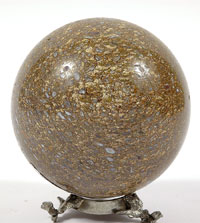 |
Agatized Dinosaur Bone Sphere. Agatized dinosaur bone occurs when the hollow bone structure of the dinosaur is replaced by quartz and trace minerals such as iron over millions of years. The best quality agatized dinosaur bone comes from the Jurassic era in Utah. 150 million year old Morrison Formation gem quality dinosaur bone was carefully shaped into a 4.25 inch sphere and polished revealing a rainbow of colors in the individual cells ranging from whites, creams, browns, yellows, orange and even green and blue. This gem quality bone sphere is from the Tom Helfrich Collection. Tom Helfrich was the author of "Dinosaur Vanishing of a Gem Bone". This gem quality dinosaur bone sphere comes on its own custom iron stand for display.
Add $15 for domestic shipping.
Estimated Value $750 - 950.
View details and enlarged photo
| Unsold |
Lot 321 |
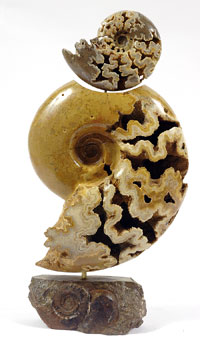 |
Ammonite Sculpture. Ammonites were cephalopods that looked liked a squid in a spiral shaped shell. This esthetic 14.5 x 7.5 inch sculpture features two 100 million year old golden brown ammonites, Phylloceras from Sidi Yahya Said, Morocco positioned atop a 6 inch long base containing a 2.75 inch long spiral ammonite. The large Phylloceras ammonite is a very large 10 inches in diameter and beautiful with colors blending from cream to golden brown and inner chambers looking like the inside of a geode with tiny brown calcite crystals. The smaller 4.5 inch ammonite has colors blending from cream to orange to light gray. The walls of some of the chambers (called Septa) have dissolved away leaving the squiggly pattern of the sutures which strengthened the ammonites shell when it was alive. The back side of each ammonite is solid and clearly shows the colorful golden brown suture lines. Photos do not do justice to this exquisitely colorful and ornate ammonite sculpture which has both natural and esthetic beauty.
Add $35 for domestic shipping.
Estimated Value $650 - 850.
View details and enlarged photo
| Unsold |
Lot 322 |
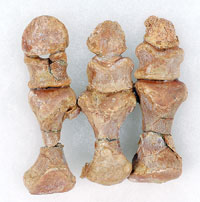 |
Ankylosaur Foot With Hooves. Armored plated Ankylosaurs with their huge clubs on their tails are one of the most recognizable dinosaurs, but despite their popularity any fossil from them except for their armored skutes is rare. Their fossils are rare because they did not live in herds or close to lakes and streams where most of the fossil dinosaurs are found. This rare front foot consists of three toes each 2 inches long with a small hoof at the end of each toe. The three toes are 2 inches wide. The particular species is Shamosaurus 90-120 million years old from the Gobi Desert of Mongolia. Shamosaurus was between 15-20 feet long when fully grown. All of the bones exhibit a lovely light brown color and are original with no restoration and are mounted in a 8 x 6 inch Riker Mount. This is the first time Ankylosaur foot bones have ever been auctioned.
Add $15 for domestic hipping.
Estimated Value $1,000 - 1,250.
View details and enlarged photo
| Unsold |
Lot 323 |
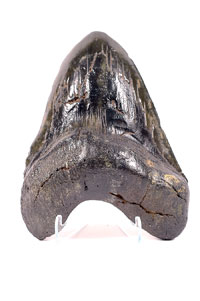 |
Carcharodon Megalodon Shark�s Tooth. Carcharodon megalodon was the largest shark that ever lived growing to more than 50 feet in length and ate whales whose bones are found right alongside with the huge teeth of megalodon. This immense 6.35 inch, 15 million year old Carcharodon tooth was found in the muddy river waters of South Carolina. Estimating the length of a shark at about 10 feet in length to every one inch of tooth, this behemoth would be over 60 feet long. This huge tooth is one of the largest ever to be auctioned but does have some chipping on the front enamel, minor chipping on the blades and about 10-15 % restoration mainly on the front root and the back enamel. This is an opportunity to purchase a really huge shark�s tooth without paying well over $1000.
Add $15 for domestic shipping.
Estimated Value $500 - 750.
View details and enlarged photo
| Unsold |
Lot 324 |
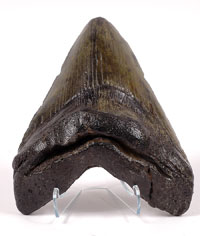 |
Carcharodon Megalodon Shark�s Tooth. Even though Carcharodon megalodon was the largest shark that ever lived growing to more than 50 feet in length most of the teeth found are only 3-4 inches in length. Teeth over 5 inches in length are in great demand and the magic number is a full 6 inches which is the size that every collector aspires to own. This immense 6 inch 15 million year old Carcharodon tooth was found in the muddy river waters of South Carolina. Estimating the length of a shark at about 10 feet in length to every one inch of tooth, this behemoth would be 60 feet long. This huge tooth has fairly complete enamel on both the front and back but does have some minor chipping on the blades and about 10% restoration on the front root. This is an opportunity to purchase a really huge shark�s tooth without paying well over $1000.
Add $15 for domestic shipping.
Estimated Value $500 - 750.
View details and enlarged photo
| Unsold |
Lot 325 |
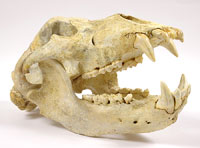 |
Complete Cave Bear Skull. Cave bears were larger than any bear alive today standing over 10 feet tall. Certainly, the fierceness of their skull bears witness to this. This complete museum quality 16 inch long skull has top quality ivory colored bone with a complete set of perfect teeth including sharp 2.25 inch long canines with lovely cream to orange enamel. Ursus spelaeus lived 50,000-100,000 years ago in Romania and other parts of northern Europe and certainly competed with early man in these areas. Cave Bear skulls are in great demand because the few skulls found are usually mounted with the rest of the skeleton to bring many thousands of dollars. This is a rare opportunity to acquire a superb skull.
Add $50 for domestic shipping.
Estimated Value $4,000 - 5,000.
View details and enlarged photo
| Unsold |
Lot 326 |
 |
Complete Mammoth Tusk. Complete tusks from a wooly mammoth Mammuthis primigenius are rare. This large complete 38 inch long 3 inch diameter tusk is from a juvenile Mammoth most probably a male because of its length and small diameter. It has been lightly polished revealing mostly chocolate brown colored ivory. These brown colors resulted from the original white ivory being mineralized over thousands of years with minerals such as vivianite and iron phosphate. This museum quality tusk was found in the Taymyr Peninsula of Siberia and is between 30,000 and 100,000 years old. Most recovered Mammoth ivory is just broken pieces unlike this over 3 foot long curved exceptional quality tusk. The only ivory that can be legally sold is fossil ivory. Comes with a display stand.
Add $75 for domestic shipping.
Estimated Value $3,000 - 4,000.
View details and enlarged photo
| Unsold |
Lot 327 |
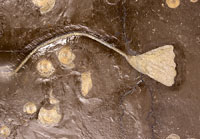 |
Crinoid and Ammonites. The 180 million year old Posidonia Shale of Holzmaden is famous for the exceptional preservation of fossil sea creatures. The black slate is a perfect matrix for the golden brown fossils that are occasionally encountered. This large 26.5 x 20 inch black slate matrix contains a beautiful large 19 inch Crinoid, Seirocrinus subangaris which consists of a 5 inch diameter Calyx (flower) and a 12 inch long curving stem. Crinoids, known as sea lilies, look like a plant but are actually animals related to starfish and have a five fold symmetry. They open their arms and filter feed small animals and detritus. Also on the matrix are 11 golden brown ammonites, Dactylioceras commune, ranging in size up to 3 inches in diameter. The large crinoids are quite rare and in tremendous demand both with collectors and decorators. A barely noticeable break in the black slate has been professionally repaired and backed with wood for stability. Large crinoid plates such as this one have sold for more than $10,000 at auction.
Add $60 for domestic shipping.
Estimated Value $2,000 - 3,000.
View details and enlarged photo
| Unsold |
Lot 328 |
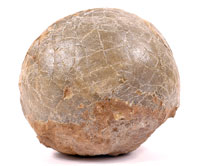 |
Dinosaur Egg Museum Quality. This prepped, complete, unhatched Duckbill dinosaur egg is 70-80 million years old, 6 x 5 inches and of museum quality, with over 90 percent of its original shell intact. The egg is completely original and has been professionally airbrushed to remove all of the minerals covering the original shell, leaving the shell exposed with its deep chocolate brown color. We do not know which Duckbill species this egg belongs to, but being the largest Duckbill egg, it might belong to the huge Duckbill dinosaur Shantungosaurus, which reached more than 50 feet in length and has been found in the same area in Henan Province of China. This museum quality dino egg makes an excellent display, having much more original egg shell than normally found and still standing on a small section of its reddish brown limestone matrix.
Estimated Value $650 - 800.
View details and enlarged photo
| Unsold |
Lot 329 |
 |
Dinosaur Tail Vertebrae With Bite Marks. This large 7.5 x 8 inch Duckbill dinosaur (probably Edmontosaurus) tail vertebrae is nearly complete but what makes it very special are four tooth marks that were made by a massive meat eating dinosaur probably T-Rex or one of the other few really large tyrannosaurs like Daspletosaurus or Albertosaurus that were present in Garfield County, Montana 67 million years ago when this fossil was buried in a river basin. Only a few tyrannosaurs had enough jaw strength and strong enough teeth to bite through solid bone. The tails of hadrosaur dinosaurs were massive with a lot of muscle that would certainly made a good meal for a tyrannosaur dinosaur. The large tyrannosaurs like T-Rex just bit into and swallowed both meat and some bone when they fed. There is no way of determining if this Duckbill dinosaur was actually killed or just scavenged by the tyrannosaur but this fossil bone does give some indication of the power of the jaws of the large predatory tyannosaurs.
Add $20 for domestic shipping.
Estimated Value $400 - 600.
View details and enlarged photo
| Unsold |
Lot 330 |
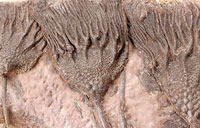 |
Five Large Crinoids on One Plate. Crinoids are related to star fish and are known as "sea lilies" because they resemble plants more than animals. Scyphocrinites was an interesting floating crinoid with its stem attached to a round air-filled bulb called a lobolith that floated on the surface of the ocean 425 million years ago in the warm seas near Tafilalet, Morocco. When the crinoids died they would separate from their flotation bulbs and settle on the ocean bottom. The flotation bulbs would continue to float away and are never found together with the crinoid crowns and stems. This magnificent grouping contains 5 complete dark grey crinoid crowns(heads) the largest being 6 x 3.5 inches also a 4 x 3 inch crown with a 7 inch stem and three others with partial stems and all having detailed feather-like feeding arms and a mosaic of small intertwined calcite plates forming the crown. This esthetic grouping of multiple crinoids nicely contrasted on a 20 x 14 inch brown stone matrix would be one of the highlights of any fossil collection.
Add $50 for domestic shipping.
Estimated Value $750 - 1,000.
View details and enlarged photo
| Unsold |
Lot 331 |
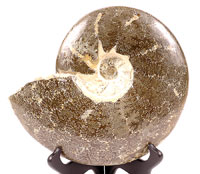 |
Giant Complete Ammonite. Ammonites are extinct cephalopods that somewhat resembled an armored squid. Since their tentacles and body were soft tissue they do not fossilize and we only find their beautiful shells remaining. This giant 10.5 x 8.5 inch Cleoniceras ammonite is 110 million years old from the island of Madagascar and is complete with hues of light to dark brown on its polished outer surface as well as some of the original mother of pearl in the center. It is one of the most striking museum quality ammonites with most of its surface covered with a fern shaped suture pattern that is outlined in a light cream color giving excellent contrast. Ammonites calcium carbonate shell was strengthened by the interlocking suture pattern and because of this it did not have to be so thick to resist the water pressure when the ammonite would dive in deeper water. Each species of ammonite had its own distinctive sulture pattern and can be identified just from its sutures. This ammonite has both size and beauty.
Add $15 for domestic shipping.
Estimated Value $500 - 700.
View details and enlarged photo
| Realized
$470 |
Lot 332 |
 |
Gigantic Trilobite. Burmeisterella is not only a very rare spiked trilobite but also one of the largest trilobites that ever lived. This enormous trilobite is 19 x 9.5 inches making it one of the largest trilobites ever offered for sale. Burmeisterella is 375 million years old from Morocco and usually only 7 to 10 inches in length with the only other specimen that was 19 inches long being sold for $9000. Even at this gigantic size Burmeisterella still had long spikes on its eyes and down the length of its body for protection from predators. This attractive black trilobite has most of its spines although there definitely is restoration on the spines as no specimen is ever found complete with all of the spines intact. With most trilobites being only 1-2 inches long, this monster looks like a dinosaur compared to a chicken in size. Definitely, this trilobite would be the highlight of any fossil collection.
Add $100 for domestic shipping.
Estimated Value $2,500 - 3,500.
View details and enlarged photo
| Realized
$2,115 |
Lot 333 |
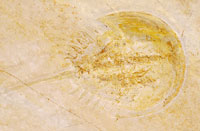 |
Horseshoe Crab in a Death Spiral. Horseshoe crabs, a close ancestor of the trilobite, are very rare in the fossil record with the best preserved specimens such as this one being found in the 150 million year old lithographic limestone of the Solnhofen Lagoon (Eichstadt, Germany). Not only is this 4 inch long golden Horsehoe crab, Mesolimulus walchi complete and well preserved but the very last seconds of its life are captured also in its death spiral represented on this large 15 x 12.5 inch creamy limestone slab. The death spiral ending with the Horseshoe crab fossil is a slightly lighter color on the slab from the sandy Lagoon bottom being disturbed by the suffocating crab. This occurred because the Lagoon water was oxygen depleted and any sea animals tossed into it by storms were quickly suffocated. Finding a fossil with a story to tell about its becoming is a fossil is extraordinary.
Add $30 for domestic shipping.
Estimated Value $900 - 1,100.
View details and enlarged photo
| Unsold |
Lot 334 |
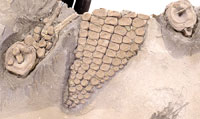 |
Ichthyosaurus Paddle and Vertebrae. Ichthyosaurs were fast swimming reptiles that resembled dolphins. This lot contains a near complete fore paddle (pectoral) and also two vertebrae and several more disarticulated phalanges. This species Ichthyosaurus communis from Lyme Regis, Dorset England was the first species of Ichthyosaur discovered in 1918 by Mary Anning who became the very first fossil dealer and inspired the ditty "she collects sea shells at the sea shore.".Ichthyosaurus is 190 million years old and would have been about 5-6 feet long as an adult. This well detailed 14 x 7.5 inch dark grey matrix contains an articulated paddle which is really the fingers of the Ichthyosaur which kept adding phalanges to create a paddle which was used for steering while it was swimming. While we only have three phalanges in our fingers, Ichthyosaurus had up to 15 phalanges as you can count in this specimen. The large number of phalanges also identifies it as a front pectoral paddle as the rear paddles had fewer phalanges. While ammonites are common from Lyme Regis, any bones from Ichthyosaurs are rarely found and in great demand.
Add $30 for domestic shipping.
Estimated Value $900 - 1,300.
View details and enlarged photo
| Unsold |
Lot 335 |
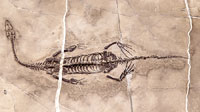 |
Kueichousaurus Skeleton. Kueichousaurus hui was the 240 million year old ancestor from Guizhou Province, China of the famous long necked sea reptiles Plesiosaurus which was made famous as being the mysterious Loch Ness monster. Kueichousaurus also lived in the ocean and had a long, flexible neck, tiny sharp teeth, webbed feet and a tail as long as its neck. This 10.5 inch long excellent 3-D fossil (about as large as they get) has well defined bones and an excellent skull with even five or six of the small pointed black teeth preserved and is well positioned on a 12 x 8 inch dark grey slate matrix with two natural white calcite veins running through the matris. All of the bones present are of top quality with all four legs present with most of toe bones but the tiny claws are either missing or disarticulated. There has been only minimal restoration mainly concentrated on the feet and toe bones.
Add $20 for domestic shipping.
Estimated Value $500 - 700.
View details and enlarged photo
| Realized
$470 |
Lot 336 |
 |
Large Ammonite Cut Pair. Ammonites were early mollusks that somewhat resembled an octopus or squid living within a protective shell and are the closest relative to the chambered nautilus which still exists today. This specimen contains both halves of a large 7.75 inch in diameter 110 million year old ammonite, Cleoniceras from the large island of Madagascar. This ammonite has been cut in half and polished to reveal the detail and beauty of the inner chambers. Ammonites started growing in the small center and added chambers spiraling outward as they grew. The living animal lived only in the last large chamber and the inner chambers were airtight and could be filled with water or air by the living ammonite using its tube-like Siphuncle to move up or down in the water.
The beautiful large 7.75 inch ammonite has inner chambers filled with various hues of colored calcite, some chambers still partially open with yellow or brown calcite crystals inside and a couple of chambers filled with gray and even red mud. The unpolished sides show interesting suture patterns as well as some of the original mother of pearl. Both halves are spectacularly displayed on a 4.5 x 5 inch black metal stand.
Add $15 for domestic shipping.
Estimated Value $400 - 500.
View details and enlarged photo
| Realized
$646 |
Lot 337 |
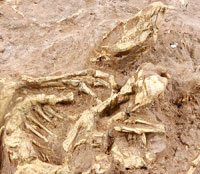 |
Original Feathered Dinosaur in Matrix. This 20 inch long important dinosaur Jeholosaurus from Central Asia is 100% real bone and is still in the same position that it died in over 125 million years ago. Jeholosaurus belongs to a little know taxa of dinosaurs know as Heterodontosauridae. These small supposedly plant eating dinosaurs are very early Ornithipods and are little understood because so few of them have been discovered. Just recently a slightly older but similar Heterodontosauridae known as Tianyulong was found in Liaoning, China as is important as it was clearly feathered with short small feathers. This means that its slightly later ancestor Jeholosaurus would also have been feathered. This is extremely important as no Ornithipod or plant eating dinosaur had ever been found that had feathers. Only some theropod, meat eating dinosaurs have been found to have feathers. Thus Jeholosaurus is a missing link animal that bridges the feather gap of Ornithipod and Theropod dinosaurs. Jehosaurus is 125-130 million years old and was found in the tuffaceous volcanic sandstone of the lower Yixian formation in Liaoning Province of Central Asia. Even the teeth of Jeholosaurus look like a cross between a meat eating and plant eating dinosaur with sharp pointed teeth in the front of the jaw and flat teeth in the rest of the jaw like a plant eating dinosaur. Perhaps they were omnivores eating both plants and insects and possibly small lizards.
This 20 inch long juvenile Jeholosaurus has been partially prepared in its original 17 x 13 inch reddish brown stone matrix keeping the dinosaur in the same curled position that it was in over 125 million years ago when it was buried in volcanic ash. The dinosaur was lying on its side with one front and one back leg exposed, the other legs are most likely still buried in the matrix. The bone quality is an excellent solid cream color which contrasts nicely with the reddish brown matrix. The front leg lies in a curled raptor-like position with one sharp claw exposed. The back leg curves into the body with one claw also visible. The all important skull has been prepared in a stunning 3-D appearance above the matrix and is excellent with almost a full set of teeth on the exposed side even with the rarely preserved sharp pointed premaxillary teeth. Several other exposed sections of bone are visible in the matrix surrounding the dinosaur. Undoubtedly, more bone is present than what has been expertly prepared. This is a rare opportunity to acquire a completely original dinosaur fossil in situ with no restoration work done to complete the specimen. Even though Jeholosaurus definitely had feathers when alive, no specimen has so far been found with any fossilized feathers.
Add $125 for domestic shipping.
Estimated Value $9,000-UP.
View details and enlarged photo
| Unsold |
Lot 338 |
 |
Pair of Unhatched Oviraptor Eggs. This original pair of complete Oviraptor eggs is 70-80 million years old from the Djadokhta formation of Ukhaa Tolgod of Mongolia. These eggs were found in the Gobi desert and are 7 inches long and belong to the largest of the two Oviraptor species called Citipati to distinguish this difference from the other smaller species. Citipati Oviraptorids were made famous by the nest of eggs with the mother Citipati sitting on top of the eggs in a brooding position. This famous specimen is displayed in the New York Museum of Natural History and was discovered in 1995. It was revolutionary to discover a dinosaur sitting on top of its eggs like a bird and only later was it discovered that Oviraptors such as Citipati also had feathers like a bird. Citipati eggs are ratite in texture and have a very thin shell which is why they are rarely found complete. This museum quality pair of eggs has sharp textured fully airbrushed detail on the shell and about 90% original shell on one and 80% shell on the other egg. The shell is a dark gray color which nicely contrasts the 10.5 x 5 inch red limestone matrix. There are probably three or more species of Oviraptor type dinosaurs that had eggs that vary in size from 5-7.5 inches, but these classic eggs definitely belong to the species of Oviraptor, Citipati first found in the 1920�s in Mongolia. Oviraptor eggs are almost impossible to find in such pristine condition.
Add $40 for domestic shipping.
Estimated Value $2,000 - 2,500.
View details and enlarged photo
| Unsold |
Lot 339 |
 |
Pareodus - 50 Million Years Old. An extinct fish from Green River, Wyoming, related to the piranha. Near complete; teeth and fins have been painted in. Approximately 10" long, nicely centered on an original limestone matrix which is 10¾ x 16". An attractive display piece.
Estimated Value $250 - 350.
View details and enlarged photo
| Realized
$147 |
Lot 340 |
 |
Sclerocephalus Amphibian Larvae Stages. Even though the earliest amphibians ventured forth on land, they still deposited their eggs and the hatching larvae went through all of their developmental stages in the water. This set of five 280 million year old fossils of Screrocephalus represents the four stages in the development of the larvae from long thin tadpole like animals with no legs but visible skin and eyes to a 2 inch long transitional animal still possessing gills with short tiny legs to a 5.5 inch long complete amphibian. These rare fossils come from a site that is now closed in Odernheim Pfatz, Germany. All five of these fossils are displayed in a 12 x 8 inch Riker Mount.
Add $25 for domestic shipping: $25.
Estimated Value $600 - 800.
View details and enlarged photo
| Unsold |
Lot 341 |
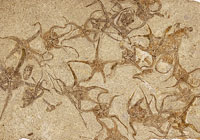 |
Starfish Mass Mortality Plate. Finding a complete starfish is not easy because the delicate arms break off quite easily during the fossilization process. Finding a mass burial of more than 20 complete and near complete starfish is extraordinary. This large 16 x 12" museum quality plate is 475 million years old from Lkaidrami, Messeu, Southern Morocco. This magnificent sea bottom slab preserves a snapshot of what life existed on the sandy bottom of the warm seas of Morocco 475 million years ago before being buried by mud or volcanic ash. There are more than 20 brittle stars (ophiuroids) up to 5 inches in diameter. Brittle starfish usually hang in groups and attach themselves to the sea bottom and filter feed on small creatures that float by.
This is a rare opportunity to acquire both a rare and dramatic fossil for both display and study.
Add $30 for domestic shipping.
Estimated Value $500 - 600.
View details and enlarged photo
| Unsold |
Lot 342 |
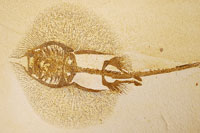 |
Stingray From Green River. The 50 million year old dry lake beds of Green River, Wyoming are famous for their exquisitely preserved fish and one of the rarest and most desirable fossil fish is the stingray. Stingrays are only rarely found and are usually not complete. This large 14 x 8 inch male Stingray is the exception in that it is 100% complete and original with no restoration. The detail of even the tiniest of bones on its bell are well detailed and the tail ends with 4 sharp stingers with their barbs visible just waiting to be used. You can tell that it is a male because of the two long claspers that extend back away from the body. Only sharks and rays possess these reproducing claspers in males. This museum quality Stingray comes from an old collection and is nicely centered on a 21.75 x 13 inch natural limestone matrix as found.
Add $50 for domestic shipping.
Estimated Value $2,500 - 3,000.
View details and enlarged photo
| Unsold |
Lot 343 |
 |
T-Rex Tooth Juvenile 1.75 Inches. This complete T-Rex tooth is 1.75 inches long.75 inch wide and rather thick for its size, has sharp squared serrations which define it as a T-Rex, and even shows a slight indentation at the root level on one side which is from a replacement tooth that was already growing behind this tooth when it was broken off when the T-Rex was feeding. All T-Rex teeth are shed teeth except the very few that are found with the dozen or so partial skeletons that have been found. This impressive and rare tooth has excellent dark brown color with no restoration with just a little feeding wear on the tip. It was found in an ancient river or lake bed on a private ranch in the 65-67 million year old Hell Creek Formation of Powder River County, Montana. All T-Rex teeth are in great demand, but those very few that are not broken and repaired are rarely encountered.
Add $15 for domestic shipping.
Estimated Value $700 - 900.
View details and enlarged photo
| Realized
$660 |
Lot 344 |
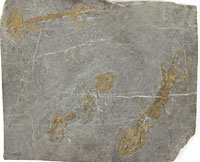 |
Three Primitive Amphibians. Discosauriscus pulcmerismus was an early 260 million year old amphibian unrelated to modern amphibians that somewhat resembled a salamander with a huge head and scaly and rough skin. Discosauriscus was an active predator in lakes and shallow pools. The two specimens on this 13 x 11 inch plate feature one 8 inch long specimen from the ventral position showing rows of small sharp teeth and one 7 inch specimen with a dorsal view showing the solid bony skull. On the same slab is a ventral view 6 inch long Microperpetron amphibian also showing some teeth. It is rare to find even one amphibian specimen but finding three on one plate is exceptionally rare. These museum quality specimens were found in a quarry near Letovice in the Czech Republic.
Add $35 for domestic shipping.
Estimated Value $2,200 - 2,700.
View details and enlarged photo
| Unsold |
Lot 345 |
 |
Triceratops Brow Horn. Triceratops with its two long brow horns and living at the same time as T-Rex is one of the most popular dinosaurs. This 13 x 6 inch brow horn is fairly large and from a juvenile Triceratops. The horns of a Triceratops are never found without cracks and are usually found in pieces but this horn was found in one piece and does have some moderate crack repair on one side. This is a near complete horn with just a little wear on the tip. The grooves in the horn represent areas where blood flowed to the horn. This is a horn core. In life the horn would have been covered with keratin (like our fingernails) and would have been about 30% larger. This large and heavy display fossil is 65-66 million years old and was found a private ranch in Montana. Not being perfect, this is an opportunity to acquire and impressive and important fossil and not pay more than $2,000 for it.
Add $25 to domestic shipping.
Estimated Value $1,000 - 1,500.
View details and enlarged photo
| Unsold |
Lot 346 |
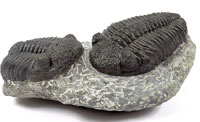 |
Trilobites Two Large Drotops. Most examples of the trilobite Drotops are only 2-3 inches long, but in the warm 375 seas near Erfoud, Morocco this same trilobite grew to almost 6 inches in length. These two large 5.5 x 3 inch black trilobites have been esthetically cut out of their grey stone matrix to crawl in a life-like position on their natural 9 x 5.5 inch gray stone base. Each trilobite is complete with excellent detail on the head with bumps (postules), complete body segments and even some hexagonal lenses in the eyes
Add $20 for domestic shipping.
Estimated Value $400 - 600.
View details and enlarged photo
| Unsold |
Lot 347 |
 |
Trio of Dinosaur Feathers. At 125-135 million years old these three possible dinosaur feathers are some of the oldest feathers known exceeded in age only by the 150 million year old Archaeopterix bird feather from Solnhofen. The first protofeather that formed in dinosaurs was just a hollow barb made out of keratin the same protein that makes up our finger nails. The next step was the separation of the barbs into filaments forming a tassel-like feather. The largest of these feathers.8 inch long has a central barb with four different filament branchings similar to some neck or tail dinosaur feathers. The second feather is a .6 inch long most likely a body feather that has a weak center barb and small thin curved filament feathers radiating outward randomly. The third .5 inch feather has no center barb but just many thin filaments that may be head or body feathers. These feathers were found in a fossilized volcanic lake bed in Liaoning in Northeastern China, the sight where many types of feathered dinosaurs have been discovered. Although it is impossible to distinguish between bird and dinosaur feathers, the only flightless animals found in Liaoning have been dinosaurs so the probability is great that these are indeed dinosaur feathers. These valuable and well defined rare feathers are housed in a 8 x 6.5 inch Riker mount.
Add $15 for domestic shipping.
Estimated Value $650 - 850.
View details and enlarged photo
| Unsold |
Lot 348 |
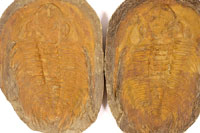 |
Two Gigantic Trilobites. This lot consists of both the positive and negative slabs of Acadoparadoxites, one of the largest and one of the very earliest trilobites (over 500 million years old) that ever lived. It is very rare to collect both the positive and negative slabs as most specimens only contain the positive when the rock is split. This gigantic trilobite was one of the largest predators of the mid Cambrian warm seas of Morocco. Found in the Atlas Mountain range of Morocco, this 14 x 10 inch trilobite has an attractive rust orange color, limonite (an iron oxide) which nicely contrasts the grayish brown matrix. Both parts are virtually complete with only minor restoration of a few of the spines on the pygidium. With most trilobites being only an inch or so in length, finding a museum quality specimen of a giant trilobite is a very rare occurrence.
Add $35 for domestic shipping.
Estimated Value $500 - 700.
View details and enlarged photo
| Unsold |
Lot 349 |
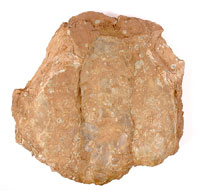 |
Tyrannosaurus Dinosaur Eggs. Tyrannosaurus bataar dinosaur eggs from Central Asia are the largest and some of the rarest dinosaur eggs known. Tyrannosaurus bataar looked virtually the same as its more famous relative T-Rex but was slightly smaller in size and older in the fossil record at 70-80 million years old. Tyrannosaurus bataar may be the direct ancestor to T-Rex of which no eggs have ever been found. Tyrannosaur eggs are very rare because unlike herbivorous dinosaurs, tyrannosaurs were solitary animals that did not lay their eggs in colonies and only a single isolated nest is ever found. This rare three egg partial nest in its original 19 x 18 inch red sandstone matrix consists of one huge 16 x 5 inch complete egg and two large partials 14 x 5 inches and 11 x 5 inches. These eggs have about 80% original shell on their exposed surface and are somewhat crushed which is almost always the case because of their immense size and the thinness of their shell. This size is just about the maximum possible because any egg cannot be any thicker or it would not allow oxygen in or waste gases to escape out and the embryo would die. These immense heavy 16 inch long eggs have definitely been identified as being from a tyrannosaur as embryos have been found in a couple of them with one even having a small skull with sharp theropod teeth. These eggs are in tremendous demand because no more can be obtained from Asia and the only ones that are available have to come from existing collections.
Add $125 for domestic shipping.
Estimated Value $4,500 - 6,000.
View details and enlarged photo
| Unsold |
Lot 350 |
 |
Winged Termites and Twigs in Colombian Amber. Amber is the fossilized tree resin. Some trees produce resins to help heal breaks and gashes. Occasionally insects become trapped in the sticky amber and are mummified (dessicated) with incredible preservation of soft tissues, muscles, microscopic detail and sometimes even color. DNA has been retrieved from amber over 65 million years old at the time of the dinosaurs. The age of amber itself cannot be determined. Only the rock it is deposited in can be tested. Colombian young amber is found mostly in the Andes mountains in remote regions and has not been properly dated. This amber with the classic golden honey color like Dominican Amber is probably between 1- 5 million years old. Such is the probable age of this extremely large 6 x 3.3 x 2.8 inch clear amber nugget weighing 562grams(over one pound). This magnificent nugget has been polished on three sides with the back left natural for effect and features dozens of scarce winged termites in a clear 5.5 x 2.8 inch window as well several twigs and dozens of wingless termites and other small insects in the interior. This rich golden amber nugget is both beautiful and massive with excellent detail of the winged termite hoard which is close to the surface and many other insects contained within.
Add $15 for domestic shipping.
Estimated Value $600 - 800.
View details and enlarged photo
| Realized
$510 |
Lot 351 |
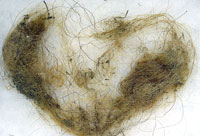 |
Wooly Mammoth Hair. This large specimen of 20,000-30,000 year old Wooly Mammoth hair comes from the only Mammoth specimen available from about a dozen frozen Mammoth carcasses that have been found in the frozen permafrost of the Indi-girka Basin of Siberia. Hair does not fossilize and therefore is extraordinarily rare in extinct animals and definitely contains much original DNA. Currently, there is an analysis of DNA from Mammoth hair similar to this specimen to get enough DNA to create a Wooly Mammoth by impregnating an African Elephant. 80% of the total Mammoth DNA has been collected. This specimen contains much more hair than usually offered and has premium pieces of the long thick reddish-brown hair that covered the body of the Mammoth. This rare specimen of Mammuthis primigenius hair was part of the collection of Dr. Gennady Baryshnikov of the USSR Academy of Sciences in Leningrad, Russia and is housed in a 12 x 8 inch Riker Mount for display.
Add $15 for domestic shipping.
Estimated Value $400 - 600.
View details and enlarged photo
| Unsold |